Physical Address
304 North Cardinal St.
Dorchester Center, MA 02124
Squamous cell papilloma may occur anywhere in the esophagus but is found most commonly in the lower third as a single, well-demarcated sessile intraluminal tumor, usually less than 1.5 cm in size. The age distribution is very wide. A giant form has been described. Multiple lesions, sometimes in association with Goltz syndrome (focal dermal hypoplasia), may also occur. The etiology of these lesions is not clear; some are related to chronic irritation and others to human papillomavirus (HPV) infection.
Histologically, squamous papilloma may be exophytic, endophytic, or spiked. The exophytic type is the most common and has a papillary architecture with a core of vascular connective tissue covered by hyperplastic, normally maturing, squamous epithelium ( Fig. 8.1 ). The spiked type has hyperkeratosis and may have papilloma virus–associated changes, including koilocytosis and multinucleation. Endophytic squamous papillomas have a smooth nodular appearance with hyperplastic squamous epithelium that is often inflamed. They are sometimes called inflammatory polyps of the esophagus.
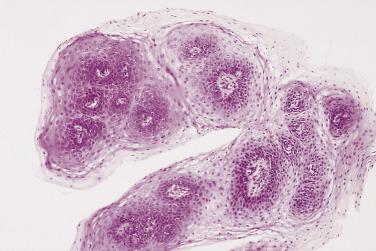
In biopsy material, squamous papilloma must be differentiated from well-differentiated verrucous squamous cell carcinoma (see later discussion). Rare cases of squamous cell carcinoma arising in association with squamous papillomatosis are described.
Adenoma is a rare polypoid tumor, which is indistinguishable histologically from gastric adenoma (see later discussion) and usually occurs as a manifestation of raised dysplasia in columnar (Barrett) esophagus. Multiple adenomatous polyps with synchronous adenocarcinoma have been reported. Rare adenoma variants include a pyloric gland type, a gastric foveolar type, and a traditional serrated adenoma.
A few cases of submucosal adenoma of the esophagus, arising from submucosal mucous glands or ducts, including pleomorphic adenomas comparable with those arising in salivary gland (see Chapter 7 ), have been described.
Epithelial dysplasia, arising in squamous or columnar epithelium, is considered to be a precancerous lesion and is characterized by cellular atypia, abnormal differentiation, and disorganized architecture. All of these features are more prominent in high-grade dysplasia and, conversely, are less pronounced in low-grade dysplasia. Because high-grade dysplasia may be histologically indistinguishable from intraepithelial or in situ carcinoma, the term intraepithelial neoplasia (of low or high grade) is often used synonymously with dysplasia.
In the esophagus, squamous cell dysplasia (also referred to as squamous cell intraepithelial neoplasia), morphologically indistinguishable from its counterpart in other squamous mucosae such as the uterine cervix, often precedes or coexists with invasive squamous cell carcinoma. Careful histologic examination of esophagectomy specimens for nonirradiated squamous carcinoma discloses low-grade and high-grade squamous dysplastic lesions (intraepithelial neoplasia of low and high grade) in the adjacent background mucosa in a high proportion of cases ( Fig. 8.2 ), and prospective studies have demonstrated the relative risk of malignancy with increasing grade of dysplasia. Endoscopically visible and histologically evident squamous dysplastic lesions frequently occur in the esophagi of high-risk populations, as in Northern China. These findings support the idea of a sequential progression from squamous cell dysplasia to invasive squamous carcinoma. Two histologic variants of squamous cell dysplasia are recognized: basal squamous dysplasia, in which the highly abnormal cells are confined to the basal layer and which is frequently associated with early invasion, and, more rarely, pagetoid squamous dysplasia characterized by dysplastic cells occupying the basal layer and midzone of the epithelium only.
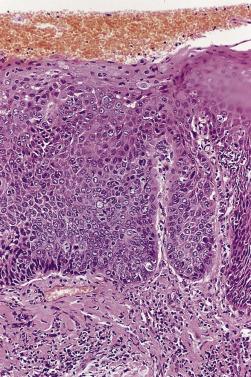
In the esophagus, glandular dysplasia is considered as a precursor of adenocarcinoma complicating Barrett esophagus; it may be present extensively or focally, with or without endoscopic abnormality. Glandular dysplasia may also be found in conjunction with obvious adenocarcinoma, adjacent to and away from the main tumor area. Glandular dysplasia may be graded into low or high grade, based on the degree of architectural or cellular abnormalities, and may be subtyped into adenomatous (intestinal) and foveolar (gastric) types. The entity basal crypt dysplasia, characterized by marked nuclear pleomorphism and maturation of the surface epithelium, is thought to be an early stage in the development of dysplasia.
So-called early cancer of the esophagus is a clinical concept that suggests curable carcinoma and has been defined by the Japanese, since 2007, as invasive carcinoma that is confined to the mucosa, with or without lymph node spread. It is best referred to as “superficial carcinoma,” which is defined as intramucosal or submucosal carcinoma, with or without lymph node metastasis. Most superficial carcinomas of the esophagus are conventional squamous carcinomas, but adenocarcinoma arising in Barrett esophagus may also present as superficial cancer.
Squamous cell carcinoma is the most common malignant tumor of the esophagus, affecting men more often than women. Its frequency increases with age, with a median age of 65 years. A marked geographic variation is seen in its incidence, which is high in central Asia, China, and South Africa and low in Europe and North America. Putative etiologic factors include smoking, alcohol consumption, dietary deficiency, fungal contamination of foodstuffs, and lye ingestion; an association also exists with the Paterson-Kelly (Plummer-Vinson) syndrome, achalasia, esophageal diverticula, and celiac disease. In most of these conditions a chronic esophagitis is seen, more often than not asymptomatic. Studies have suggested a role for HPV, especially types 16 and 18, in the pathogenesis of some esophageal cancers, but this seems to vary according to the geographic incidence of esophageal carcinoma. Apart from the rare occurrence but very high frequency of esophageal carcinoma in autosomally inherited tylosis (nonepidermolytic palmoplantar keratoderma) ( Fig. 8.3 ), little evidence exists that heredity plays a major part. Studies of molecular abnormalities in carcinoma of the esophagus have suggested a role for autocrine stimulation of overexpressed epidermal growth factor receptors by epidermal growth factor and transforming growth factor-α; amplification of cyclin D1; mutation of p53 and MTS1; allelic loss in the p53, Rb, and APC genes; and loss of heterozygosity (LOH) at loci on chromosomes 3p, 9q, 10p, 17q, 18q, 19q, and 21q. The LOH on chromosome 17q in about 70% of sporadic esophageal squamous carcinomas is of particular interest because it usually involves the locus of the gene for inherited tylosis (identified as the RHBDF2 gene on 17q25.1), suggesting that this acts as a tumor suppressor gene for esophageal cancer.
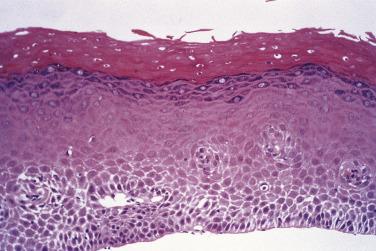
Squamous cell carcinomas usually occur in the middle or lower third of the esophagus and may present clinically with progressive dysphagia, weight loss, anemia, or, rarely, esophageal perforation. Tumor spread, locally within the mediastinum or more widely after lymphovascular permeation, is associated with a poor prognosis. Superficial (early) squamous cell carcinoma, where the lesion is confined to the mucosa or submucosa, has a much better outlook ; most such tumors are asymptomatic and are diagnosed incidentally during endoscopy with or without chromoendoscopy and narrow band imaging. About 10% of patients with esophageal squamous carcinoma, whether advanced or superficial, have synchronous or metachronous squamous cell carcinoma of the oropharyngeal ring.
The uncommon verrucous variant of squamous cell carcinoma, although very well differentiated, slowly growing, and rarely metastatic, not infrequently proves fatal because of failure to make a diagnosis before extensive local spread has occurred. This is because endoscopic biopsies regularly produce pieces of well-differentiated squamous epithelium, showing minimal atypia, that are misdiagnosed by the pathologist as reactive epithelial hyperplasia, even when the endoscopic appearances are clearly sinister. Correlation between clinical, endoscopic, radiologic, and histologic features is therefore particularly important in reaching the correct diagnosis.
Squamous cell carcinomas are usually circumferential, partly exophytic, partly ulcerating lesions that result in esophageal stricture ( Fig. 8.4 ). Early (superficial) tumors are often pale, plaquelike nodules that occasionally undergo surface erosion to give an appearance resembling esophagitis, or they may be virtually unrecognizable on gross examination ( Fig. 8.5 ). Well-differentiated verrucous squamous cell carcinomas are usually large, warty lesions ( Fig. 8.6 ) with well-demarcated, pushing margins that can be recognized on the cut surface. On the other hand, some poorly differentiated, widely infiltrative lesions can give rise to a diffuse, ill-defined thickening of the esophageal wall, reminiscent of gastric linitis plastica. Postcricoid carcinomas in the Paterson-Kelly syndrome have no special macroscopic features; their accompanying esophageal webs may be seen as a thin connective tissue diaphragm.
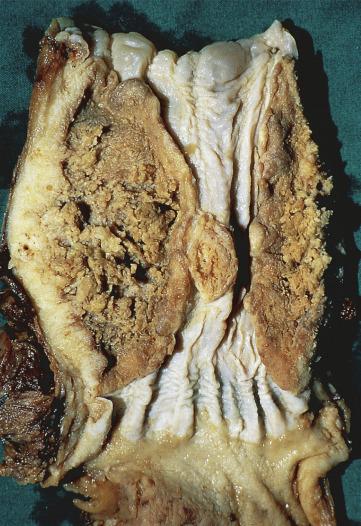
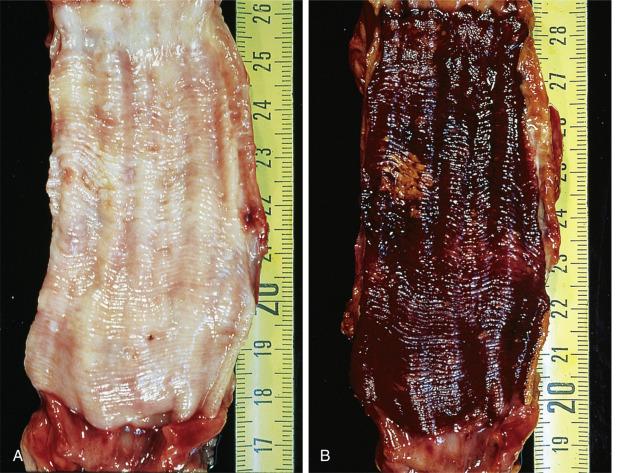
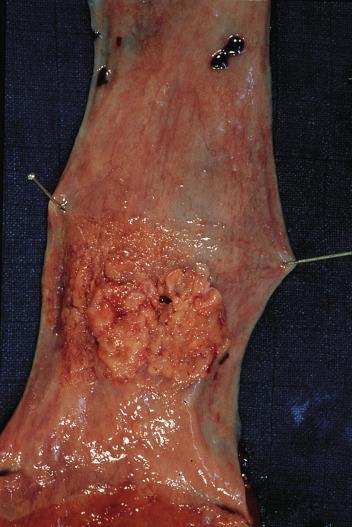
Multicentric esophageal squamous cell carcinomas do occur rarely, but data about their incidence and pathogenesis are conflicting. Multicentricity may be due to synchronous malignant transformation of several coexisting dysplastic lesions or to submucosal spread from a single primary tumor giving rise to satellite nodules. Occult intramural spread of this sort may result in inadequate surgical excision, and careful histologic examination of resection margins should always be undertaken to check for this.
Squamous cell carcinomas of the esophagus show a range of differentiation from abundantly keratinized, well-differentiated lesions ( Fig. 8.7 ) containing prominent intercellular bridges to poorly differentiated, virtually anaplastic, large or small cell tumors in which morphologic evidence of squamous differentiation may be identified only after prolonged searching ( Fig. 8.8 ). Sometimes this spectrum of appearances may occur within different areas of a single lesion. Occasionally the squamous cell carcinoma is combined with a second, smaller component, of either adenocarcinoma or small cell carcinoma (see later discussion). Tumors in resection specimens usually demonstrate invasion into, and often through, the muscle coats with infiltration of the extramural mediastinal tissues to a variable degree; the extent of such local spread is an important prognostic factor. Many cases show widespread infiltration of intramural, especially submucosal, lymphatics, and this, along with spread along the ducts of esophageal glands, may lead to extensive proximal and distal spread of tumor within the esophageal wall and the appearance of satellite deposits. The presence of a marked desmoplastic reaction or a pronounced lymphocytic response to the tumor at the advancing margin makes the macroscopic assessment of the extent of invasion difficult, and histologic evaluation of the deep (circumferential) margin is important in assessing adequacy of excision. Other histologic indicators of aggressive behavior include poor differentiation, tumor necrosis, and lymphatic or vascular invasion.
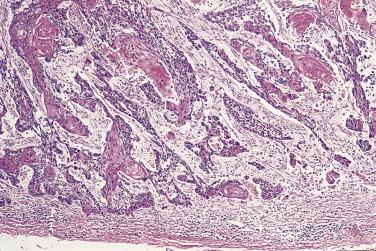
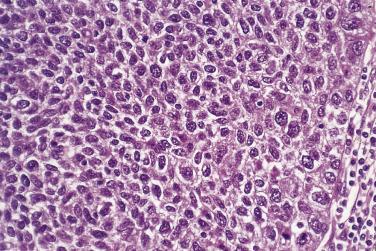
Superficial spreading carcinoma is a histologic variant of superficial squamous carcinoma characterized by in situ or invasive carcinoma confined to the mucosa and submucosa that extends over a distance of 50 mm or more. It is often associated with multiple cancerous lesions, making it important for the surgeon to identify the extent of the disease to ensure complete resection.
The verrucous variant of squamous cell carcinoma is characterized by broad papillae of well-differentiated keratinizing squamous epithelium showing minimal cytologic atypia; these invade the underlying tissues over a broad front in the form of well-demarcated bulbous epithelial tongues ( Fig. 8.9 ). Difficulties in its diagnosis have been highlighted earlier.
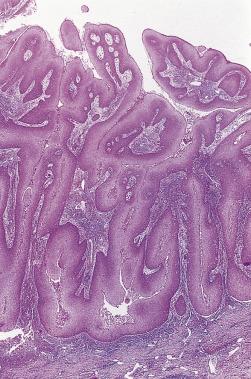
Rare reports exist of Epstein-Barr virus (EBV)–associated squamous cell carcinoma with lymphoid stroma, which, like its more common gastric counterpart, is characterized by poorly differentiated carcinoma with an associated intense inflammatory infiltrate, including lymphoid follicles.
Superficial basal cell carcinomas, morphologically similar to those of the skin and with an apparently good prognosis, have also been described very rarely. They should be distinguished from another less well-recognized variant, the so-called basaloid squamous cell carcinoma in which typical invasive and/or in situ squamous cell carcinoma is combined with a “basaloid” component comprising solid, discrete nests or lobules of small, mitotically active cells with hyperchromatic nuclei ( Fig. 8.10 ), sometimes with microcystic spaces containing basophilic material or central foci of necrosis, but without significant peripheral palisading. Basaloid squamous carcinoma is most common in elderly men and has an aggressive behavior with high metastatic potential. Some examples show marked stromal hyalinization, producing an appearance reminiscent of adenoid cystic carcinoma; indeed it has been suggested that many examples in the literature of esophageal adenoid cystic carcinomas that have demonstrated a much more aggressive behavior than their salivary gland counterparts are misdiagnosed basaloid squamous carcinomas. In contrast to basaloid carcinomas elsewhere, esophageal lesions seem not to be associated with HPV infection.
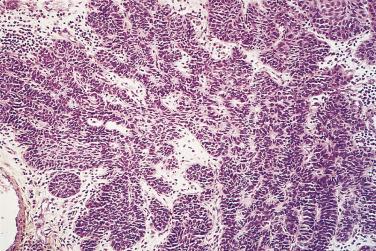
The histologic diagnosis of squamous cell carcinoma of the esophagus is usually straightforward. The major differential diagnosis in biopsy interpretation is from regenerating squamous epithelium at the margin of a benign ulcer, where expansion of the basal proliferative zone and brisk mitotic activity may occur. The most useful features pointing to benign reactive hyperplasia are surface maturation of the epithelial cells and a lack of nuclear pleomorphism or atypical mitoses. Particular difficulty may arise when these epithelial changes are accompanied by bizarre reactive stromal cells in association with granulation tissue ( Fig. 8.11 ), because these may display hyperchromatic, pleomorphic nuclei and large nucleoli that can easily tempt the unwary into a diagnosis of invasive carcinoma. Paradoxically, these stromal cells usually show little mitotic activity, and their lack of cohesion betrays their nonepithelial nature. Another source of difficulty is the cytonuclear atypia of squamous epithelial cells that follows irradiation, misinterpretation of which may lead to a false diagnosis of recurrent malignancy after radiotherapy. In the case of verrucous carcinoma, unequivocal invasion is seldom demonstrable in superficial biopsies, and clinicopathologic correlation is often vital in reaching the correct diagnosis. The distinction between basaloid squamous cell carcinoma and adenoid cystic carcinoma is discussed later.

It is now widely accepted that spindle cell carcinoma, polypoid carcinoma, carcinosarcoma, and pseudosarcoma are synonyms for an unusual esophageal epithelial neoplasm with distinctive macroscopic and microscopic features. The tumors usually present with a short history of dysphagia and weight loss, most commonly in middle-aged or elderly men. Most reports suggest a better prognosis than for typical squamous cell carcinoma.
The tumors are virtually always bulky, polypoid, intraluminal esophageal growths, sometimes with a quite narrow pedicle ( Fig. 8.12 ), situated in the middle or lower third of the esophagus, and measuring up to 15 cm in length.
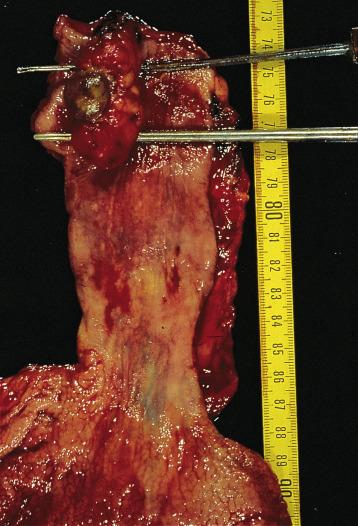
These tumors are characterized by a biphasic pattern with a malignant spindle cell sarcomatoid component and an in situ or invasive carcinoma that is usually of squamous type ( Fig. 8.13 ), but occasionally may show glandular or neuroendocrine differentiation. The relative proportions of these components vary greatly from case to case, though the sarcomatoid element often predominates. Indeed, the carcinomatous tissue is quite often confined to the most superficial part of the mass where it is prone to destruction by ulceration. The sarcomatoid component usually consists of haphazardly arranged or interlacing bundles of mitotically active spindle cells, admixed with variable numbers of bizarre giant cells and, occasionally, heterologous components, including neoplastic bone, cartilage, or striated muscle. Interestingly, the sarcoma-like component appears to have a higher proliferation index and is more frequently aneuploid than the epithelial component. The stroma may contain conspicuous amounts of collagen or have a myxoid appearance. Despite the large size and anaplastic appearance of the tumor, infiltration of the esophageal wall is sometimes only superficial, and a significant number of reported cases have been confined to the mucosa and submucosa. When metastases occur, they may contain the carcinomatous component, the spindle cell element, or both. Although the precise histogenesis of this tumor is not understood, the most popular explanation for its sarcomatoid component is spindle cell differentiation or so-called mesenchymal metaplasia within what is essentially an invasive squamous cell carcinoma. In most cases, the spindle cell component retains at least focal keratin positivity, and LOH studies support this viewpoint, hence the term carcinosarcoma is inappropriate. However, the clinical and pathologic features are sufficiently distinctive to warrant its separation as a special entity.
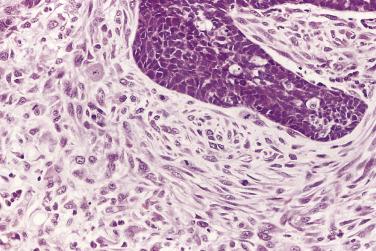
Problems may arise when a biopsy, or even a sample from a resection specimen, shows only the spindle cell component of the tumor, when the main differential diagnosis is polypoid leiomyosarcoma. Gastrointestinal stromal tumor (GIST) should also be considered in the differential diagnosis but is rare in the esophagus and typically is cytologically more bland (see later discussion). Usually a careful search for a carcinomatous component in further sections allows the correct diagnosis to be made. In biopsies this means further levels from the tissue block; in a resection specimen, careful sampling of the nonulcerated tumor surface, or of the adjacent background mucosa, is most likely to be fruitful, but if this fails then examination of regional lymph nodes may identify metastases showing epithelial differentiation. Unequivocal immunopositivity for keratin in a spindle cell tumor, if present, would support the diagnosis. A diffuse strong positive reaction for desmin and smooth muscle actin would suggest leiomyosarcoma, whereas KIT immunopositivity suggests a GIST. However, KIT expression has been described in a carcinosarcoma, but this may be an artifact of antigen retrieval. The combination of florid reactive epithelial changes and bizarre stromal cells in granulation tissue at the margin of benign esophageal erosions or ulcers (see earlier) may raise the possibility of spindle cell carcinoma at first sight, but correlation with the endoscopic appearances usually allows the correct diagnosis to be made.
Most primary esophageal adenocarcinomas arise in the lower esophagus within a background of the glandular (columnar) metaplasia of Barrett esophagus; hence most cases are associated with chronic gastroesophageal reflux. Risk factors for the development of carcinoma in Barrett esophagus include the presence of intestinal metaplasia, male gender (in most studies), increasing age, body mass index and smoking. There also appears to be a positive correlation between the length of the metaplastic segment and the risk of carcinoma. Many genetic alterations have been reported in Barrett adenocarcinoma. Mutations of the p53 gene, accompanied by chromosome 17p allelic loss, c-erbB-2 overexpression, p16 mutations, and LOH, and gene methylation play an important role in the pathogenesis of the tumor and have been described in dysplasia and nonneoplastic metaplastic Barrett-type mucosa. Accumulation of p53 protein in the setting of Barrett esophagus may predict malignant progression.
Some esophageal adenocarcinomas are diagnosed in patients without a prior clinical diagnosis of Barrett esophagus and present at a late stage with progressive dysphagia and weight loss, resulting from extensive infiltration through the esophageal wall. The prognosis in these patients with symptoms is very poor. Endoscopic surveillance of patients with Barrett esophagus, however, has led to the identification of tumors at an early stage and an improved prognosis.
Esophageal adenocarcinomas occurring in the absence of histologically demonstrable Barrett esophagus are infrequent and many may represent cases where the original metaplastic mucosa has been destroyed by the tumor. Adenocarcinoma may also rarely arise in heterotopic gastric mucosa, such as in the so-called cervical inlet patch in the upper esophagus.
Most adenocarcinomas are flat, ulcerating, infiltrative lesions that lead to stenosis of the esophageal lumen. Some have an exophytic, polypoid component; in a few cases, the whole tumor is of this type. The background metaplastic Barrett mucosa, when visible, has a red, finely granular appearance that can be distinguished readily from the paler, smooth esophageal squamous epithelium.
Most examples are tubular or papillary adenocarcinomas of “intestinal” pattern and show variable differentiation with a morphologic spectrum that is very similar to adenocarcinomas of the gastric cardia ( Fig. 8.14 ). High-grade dysplasia in the background Barrett-type metaplastic glandular epithelium is very common ( Fig. 8.15 ). Some tumors have the pattern of mucinous adenocarcinoma, with prominent extracellular mucous production, but the diffuse type of signet ring carcinoma is very unusual. Mucinous and signet ring cell carcinomas, however, may be more likely to regress with preoperative chemoradiation. Although endocrine cells are commonly found in Barrett metaplasia and dysplasia, they are found in only about 20% of esophageal adenocarcinomas, but may be seen after neoadjuvant chemoradiotherapy. Adenocarcinoma mixed with neuroendocrine (carcinoid) tumor has been described at this site. Rare reports also exist of tumors showing areas of squamous differentiation, hepatoid adenocarcinoma, and one carcinosarcoma (more likely sarcomatoid carcinoma by modern criteria) in which the epithelial component was adenocarcinomatous. The poor outlook for symptomatic (nonscreened) tumors, even when they are resectable, is explained by the fact that more than 80% show infiltration through the esophageal muscular coat, often with conspicuous perineurial invasion and lymph node metastases.
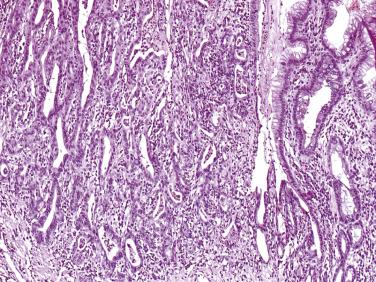
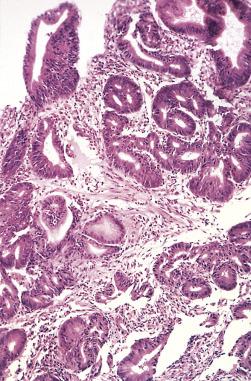
Difficulties in histologic diagnosis are largely confined to esophageal biopsies and relate to the differentiation between reactive hyperplasia of the glandular epithelium, dysplasia, and indisputable invasive adenocarcinoma. Principles involved are identical to those in the biopsy diagnosis of gastric adenocarcinoma and are considered fully in later discussion, in conjunction with the Vienna classification of precancerous lesions (see page 427 ). The often difficult distinction between high-grade dysplasia in Barrett mucosa and adenocarcinoma in biopsies, based on the demonstration of unequivocal invasion (single cell infiltration of the lamina propria or desmoplasia), is not always critical because high-grade dysplasia may be associated with synchronous or metachronous invasive malignancy, and expert high-resolution endoscopy should be carried out in all patients with biopsy-detected high-grade dysplasia.
Endoscopic therapies, including endoscopic mucosal resection (EMR) or mucosal ablation therapies, are the preferred management for high-grade dysplasia and intramucosal adenocarcinoma (pT1a) ( Table 8.1 ). Careful pathologic examination of the endoscopic resection specimen (which should always be performed with therapeutic intent) is therefore required to evaluate depth of invasion and staging. It is important to recognize the frequent duplication of the muscularis mucosae that occurs in Barrett esophagus and not overdiagnose submucosal invasion. If the endoscopic resection specimen subsequently reveals submucosal invasion (pT1b), then surgery should be considered. Pathologic assessment of the endoscopic resection specimen containing adenocarcinoma should also include assessment of completeness of excision, degree of differentiation, and whether lymphovascular invasion is present. Clear resection margins, good differentiation (G1), and absence of lymphovascular invasion are all indicators of good prognosis in early carcinoma. After ablation therapy, biopsy follow-up may identify residual tumor covered by regenerated squamous epithelium.
| T—Primary Tumor | |
| pT1 | Tumor invades lamina propria, muscularis mucosae, or submucosa |
| pT1a | Tumor invades lamina propria or muscularis mucosae |
| pT1b | Tumor invades submucosa |
| pT2 | Tumor invades muscularis propria |
| pT3 | Tumor invades adventitia |
| pT4 | Tumor invades adjacent structures |
| pT4a | Tumor invades pleura, pericardium, azygous vein, diaphragm or peritoneum |
| pT4b | Tumor invades other adjacent structures such as aorta, vertebral body, or trachea |
| N—Regional Lymph Nodes | |
| pN0 | No regional lymph node metastasis |
| pN1 | Metastasis in 1–2 regional lymph nodes |
| pN2 | Metastasis in 3–6 regional lymph nodes |
| pN3 | Metastasis in 7 or more regional lymph nodes |
| M—Distant Metastasis a | |
| M0 | No distant metastasis |
| M1 | Distant metastasis present |
a Pathologic staging cannot usually comment on the presence or absence of distant metastasis, unless biopsies of distant organs have been submitted for histologic examination.
Great confusion exists in the literature regarding the nomenclature, definition, and histogenesis of these two esophageal tumors, making evaluation of published reports very difficult. Examples of “classic” mucoepidermoid carcinoma and adenoid cystic carcinoma arising from the submucosal glands of the esophagus, as defined strictly by the criteria used for neoplasms of the salivary glands (see Chapter 7 ), are extremely uncommon. They are usually small, intramural lesions covered by an intact, nonneoplastic, squamous epithelium and are associated with a relatively good prognosis.
Most published cases of esophageal mucoepidermoid carcinoma are, however, quite different; they are large, aggressive tumors in which mucoepidermoid areas are intermingled with other elements, usually classic squamous cell carcinoma or undifferentiated carcinoma. These tumors frequently metastasize widely, and their prognosis is similar to that of pure squamous cell carcinoma. Moreover, the so-called mucoepidermoid elements can show keratinization, not a feature of the classic tumor. Some authors have emphasized the similarity of adenoid cystic carcinoma to the so-called basaloid squamous cell carcinomas described previously, which may contain areas with stromal hyalinization and a microcystic pattern. However, adenoid cystic carcinoma differs from basaloid squamous cell carcinoma in that it occurs more commonly in women and at an earlier age, shows myoepithelial differentiation and absence of associated squamous cell carcinoma, has bland nuclear features and rare mitoses, and has a much better prognosis. The finding of glandular, mucus-secreting, and cribriform elements in as many as 21% of esophageal squamous cell carcinomas, usually forming a minority component in the more superficial parts of the tumor, suggests that this whole spectrum of tumors may best be regarded as variants of squamous cell carcinoma showing bidirectional differentiation.
Several reports exist of so-called adenosquamous carcinoma, a rare tumor made up of invasive adenocarcinoma and squamous cell carcinoma, the latter often keratinized. Most cases have occurred in the lower esophagus, in association with Barrett esophagus. It has also been described intermingled with spindle cell carcinoma.
In the World Health Organization (WHO) 2019 classification, neuroendocrine carcinoma (NEC) of the esophagus is classified as NEC of small cell type or large cell type.
Both clinically and pathologically, this rare high-grade malignant tumor resembles its counterparts in the lung. It is somewhat more common in men and usually presents in the middle-aged or elderly with dysphagia and weight loss. Only rarely are there symptoms attributable to ectopic hormone secretion. The prognosis is very poor because of early and widespread metastasis.
Most reported cases are large, exophytic, and infiltrative masses ( Fig. 8.16A ) situated in the lower or middle third of the esophagus. Occasionally, multiple tumor foci may be present. A superficial variant has also been described.
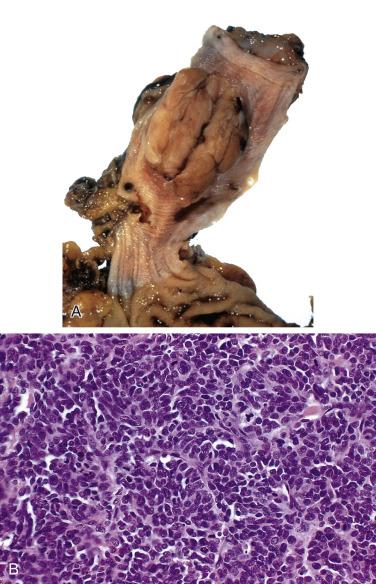
The small cell NEC consists of small anaplastic cells with scanty cytoplasm and round to oval hyperchromatic, often molded, nuclei with inconspicuous nucleoli but frequent mitoses (see Fig. 8.16B ). The cells usually form sheets, often with areas of necrosis; occasionally they are arranged in nests, cords, ribbons, or rosettes. Vascular invasion and lymph node metastases are common. NEC of large cell type may be more frequent, and is characterized by intermediate to large cells with prominent nucleoli and more abundant cytoplasm. Evidence of endocrine differentiation is patchy and variable, both between and within cases, and includes immunopositivity for endocrine markers (chromogranin A, synaptophysin, or CD56) or ultrastructural demonstration of neurosecretory granules. Endocrine-type amyloid deposition may be seen. In a significant proportion of cases, esophageal NEC of small cell type is combined with in situ or invasive squamous cell carcinoma or adenocarcinoma (mixed neuroendocrine-nonneuroendocrine neoplasm [MiNEN]), reflecting multidirectional differentiation within the tumor.
Esophageal NEC of small cell type should be distinguished from secondary spread from a lung primary (by imaging and clinicopathologic correlation), poorly differentiated squamous cell carcinoma, basaloid squamous carcinoma (which is immunonegative for endocrine markers), and malignant lymphoma. It should be noted that thyroid transcription factor 1 (TTF1) expression can be seen in primary esophageal NEC of small cell type.
Choriocarcinoma has been described in the esophagus in pure form, in association with adenocarcinoma or squamous cell carcinoma, and as a secondary lesion due to direct spread from a mediastinal choriocarcinoma.
Pagetoid infiltration of the esophageal squamous epithelium from underlying adenosquamous carcinoma, mucous gland carcinoma, and adenocarcinoma has been reported. A similar pattern of spread may occur in esophageal malignant melanoma; mucin histochemistry and immunocytochemistry for carcinoembryonic antigen and S100 protein should distinguish these lesions in biopsy material.
Esophageal carcinoma, irrespective of its histologic type, is usually staged by the TNM system (see Table 8.1 ). The risk of nodal metastases in early esophageal adenocarcinoma has been shown to correlate (in most studies) with the depth of invasion into the different layers of the mucosa and submucosa, leading to the subdivision of early (pT1) carcinomas into three or four categories for pT1a carcinomas and three categories for pT1b carcinomas ( Tables 8.2 and 8.3 ). However, assessing depth of submucosal invasion, into upper (sm1), middle (sm2), or lower (sm3) thirds, can be difficult in endoscopic resection specimens because of the absence of muscularis propria. Alternatively, the depth of invasion into the submucosa can be measured; the sm1 carcinoma invades less than 200 microns, the sm2 carcinoma invades between 200 and 400 microns, and the sm3 carcinoma invades more than 400 microns into the submucosa.
| pT1a | Tumor invades lamina propria or muscularis mucosae |
| m1 | High-grade dysplasia (carcinoma in situ) |
| m2 | Carcinoma invades lamina propria on the newly formed muscularis mucosae, newly formed muscularis mucosae, and/or original lamina propria |
| m3 | Carcinoma invades the deeper original (true) muscularis mucosae |
| pT1b | Tumor invades submucosa |
| sm1 | Carcinoma invades upper third of submucosa |
| sm2 | Carcinoma invades middle third of submucosa |
| sm3 | Carcinoma invades lower third of submucosa |
| pT1a | Tumor invades lamina propria or muscularis mucosae |
| m1 | Carcinoma limited to lamina propria on newly formed muscularis mucosae |
| m2 | Carcinoma invades newly formed muscularis mucosae |
| m3 | Carcinoma invades original lamina propria between newly formed muscularis mucosae and original (true) muscularis mucosae |
| m4 | Carcinoma invades original (true) muscularis mucosae |
| pT1b | Tumor invades submucosa |
| sm1 | Carcinoma invades upper third of submucosa |
| sm2 | Carcinoma invades middle third of submucosa |
| sm3 | Carcinoma invades lower third of submucosa |
The pathology report should also include a statement on the completeness of excision. In an endoscopic resection specimen, this will include assessment of the lateral and deep margins. In a formal resection specimen this will include assessment of the proximal and distal resection margins and the circumferential resection margin, though the prognostic significance of the latter is controversial.
The examination and reporting of resection specimens for carcinoma after preoperative neoadjuvant therapy require special precautions. Indeed, the degree of superficial and deep tumor regression may be such that no naked-eye mucosal lesion is seen. Only examination of the mucosal surface with a hand lens and careful palpation of the wall may disclose a scarred or thickened area. The latter must then be entirely blocked for histologic study. Systems of grading tumor regression have been proposed, based on a semiquantitative assessment of residual cancer versus fibrosis. The difficulty with using these is that the degree of tumor-associated fibrosis present before neoadjuvant therapy is unknown. More important is the careful pathologic staging of the extent of residual tumor in the posttreatment resection specimen.
Primary esophageal malignant melanoma is a rare but well-documented neoplasm, occurring most frequently in the middle or lower esophagus of middle-aged and elderly individuals. Patients present with dysphagia. The prognosis is very poor and, unlike cutaneous melanoma, does not appear to be related to the thickness of the primary lesion. Secondary spread of melanoma to the esophagus occurs more commonly but is still rare.
Most malignant melanomas have macroscopic features that are indistinguishable from those of other primary esophageal malignancies, although many reports describe a polypoid intraluminal growth pattern. The majority are grossly pigmented ( Fig. 8.17 ). As with cutaneous melanoma, the primary tumor may be surrounded by so-called satellite lesions.
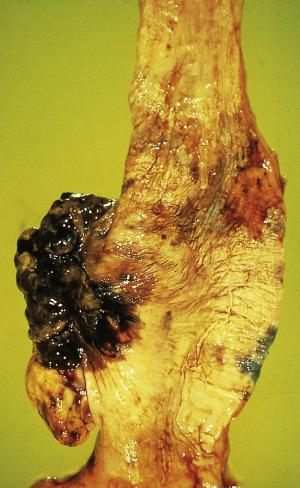
No special histologic features distinguish esophageal malignant melanomas from those arising in the skin or at other mucosal surfaces; they show the same range from epithelioid to spindle cell types ( Fig. 8.18 ) and may be pigmented or amelanotic. Whereas many have an ulcerated, nodular-type growth pattern, some are of superficial spreading type with conspicuous pagetoid or lentiginous ( Fig. 8.19 ) infiltration of the adjacent squamous epithelium by nests of neoplastic melanocytes. Junctional activity in the adjacent epithelium is also common, and cases are reported in association with more widespread focal or diffuse esophageal melanosis (see Fig. 8.17 ) and melanocytic atypia. In contrast, melanocytes are found in only some 4% of individuals without esophageal disease, although their numbers may increase with chronic inflammation and in association with esophageal carcinoma. The histologic features of primary esophageal melanomas do not predict their behavior.
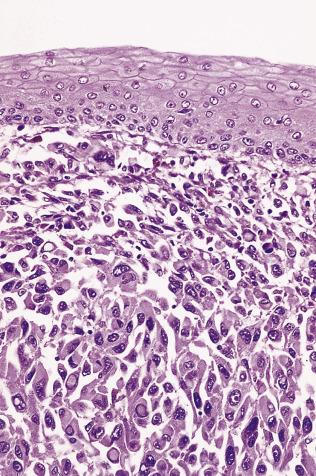
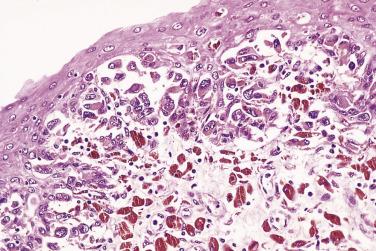
Amelanotic malignant melanomas have to be distinguished from poorly differentiated carcinomas and sarcomas. Immunohistochemistry for S100, Melan-A, and HMB-45 is invaluable, as is the presence of melanocytic atypia or pagetoid melanomatous infiltration of the adjacent epithelium (after excluding true Paget disease; see earlier). The latter features are also useful in distinguishing primary tumors from metastatic melanoma. It is important to be aware that malignant melanomas can express KIT, even in the absence of KIT mutation. Although virtually all esophageal melanocytic neoplasms are malignant melanomas, we are aware of one case report of a benign melanocytic lesion that was possibly a blue nevus.
Smooth muscle tumors are uncommon and present most often in middle age with dysphagia or heartburn. Many are asymptomatic, and a minority cause bleeding. They are somewhat commoner in men, and their frequency increases along the length of the esophagus (i.e., distally). Leiomyomas are the most common mesenchymal tumor of the esophagus and greatly outnumber leiomyosarcomas, which tend to occur in an older age group. Both lesions are usually solitary, though multiple leiomyomas are described in patients with multiple endocrine neoplasia type 1, and sometimes in the setting of so-called diffuse leiomyomatosis of the esophagus, most often associated with Alport syndrome and deletion of COL4A5 or COL4A6 . It is impossible to obtain good prognostic information on esophageal leiomyosarcoma because of its rarity and the fact that some reported cases appear to be misdiagnosed spindle cell carcinomas. Nevertheless, it appears that the clinical behavior is related to the extent of local spread at diagnosis; tumors that are resectable have a favorable outlook. Approximately one-third of leiomyosarcomas have bloodborne metastases.
Tumors may arise from any of the smooth muscle coats of the esophagus, usually producing large polypoid, intraluminal masses covered by mucosa ( Fig. 8.20 ) that may undergo secondary ulceration; less frequently encountered are well-demarcated, lobulated, extramural mediastinal tumors. Clinically significant tumors that are confined to the wall of the esophagus are rare, though it is not uncommon to find incidental tiny leiomyomas within the muscularis propria or even the muscularis mucosae of the gastroesophageal junction (GEJ) at autopsy or in resection specimens—so-called seedling leiomyomas. Smooth muscle tumors classically show a bulging gray whorled cut surface, sometimes with flecks of calcification, but leiomyosarcomas are often more fleshy, with areas of necrosis and an infiltrative growth pattern ( Fig. 8.21 ).
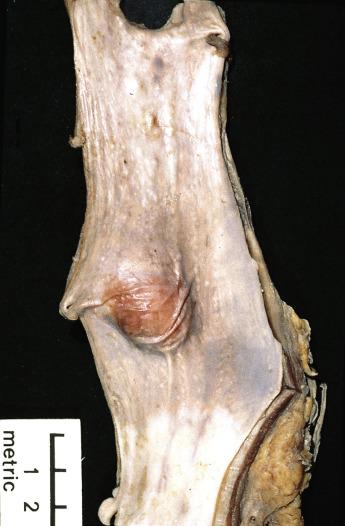
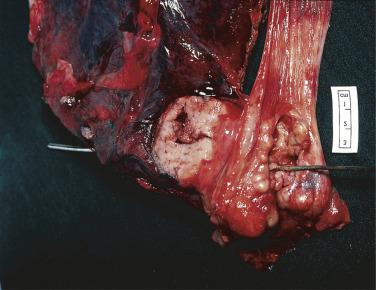
Become a Clinical Tree membership for Full access and enjoy Unlimited articles
If you are a member. Log in here